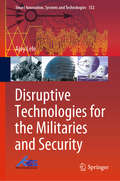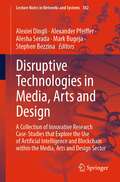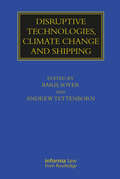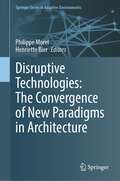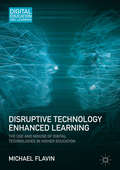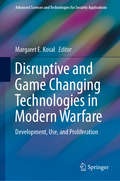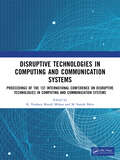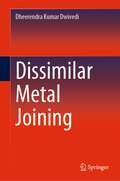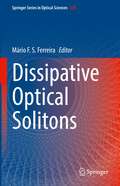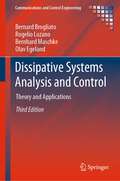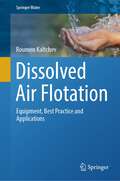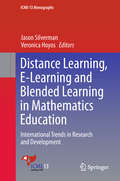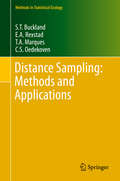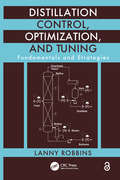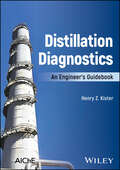- Table View
- List View
Disruptive Technologies for Society 5.0: Exploration of New Ideas, Techniques, and Tools
by Vikram BaliThis book investigates how we as citizens of Society 5.0 borrow the disruptive technologies like Blockchain, IoT, cloud and software-defined networking from Industry 4.0, with its automation and digitization of manufacturing verticals, to change the way we think and act in cyberspace incorporated within everyday life. The technologies are explored in Non-IT sectors, their implementation challenges put on the table, and new directions of thought flagged off. Disruptive Technologies for Society 5.0: Exploration of New Ideas, Techniques, and Tools is a pathbreaking book on current research, with case studies to comprehend their importance, in technologies that disrupt the de facto. This book is intended for researchers and academicians and will enable them to explore new ideas, techniques, and tools.
Disruptive Technologies for Sustainable Development
by G. Nagappan V. Uma RaniWe feel greatly honoured to have been assigned the job of organizing the AICTE Sponsored International Conference on Application of AI, ML, DL, Big Data on Recent Societal Issues (ICARSI’2023) on April 21 & April 22,2023 at Saveetha Engineering College. The international conference is a platform that brings together the brightest minds from across the globe to share their ideas and insights on the recent societal issues with Artificial intelligence, Machine Learning, Deep Learning, Big data and emerging technologies. With an aim to promote collaboration and foster innovation, this conference promises to be a melting pot of ideas and knowledge sharing.
Disruptive Technologies for the Militaries and Security (Smart Innovation, Systems and Technologies #132)
by Ajey LeleThis book debates and discusses the present and future of Disruptive Technologies in general and military Disruptive Technologies in particular. Its primary goal is to discuss various critical and advanced elucidations on strategic technologies. The focus is less on extrapolating the future of technology in a strict sense, and more on understanding the Disruptive Technology paradigm. It is widely accepted that technology alone cannot win any military campaign or war. However, technological superiority always offers militaries an advantage. More importantly, technology also has a great deterrent value. Hence, on occasion, technology can help to avoid wars. Accordingly, it is important to effectively manage new technologies by identifying their strategic utility and role in existing military architectures and the possible contributions they could make towards improving overall military capabilities. This can also entail doctrinal changes, so as to translate these new technologies into concrete advantages.
Disruptive Technologies in Media, Arts and Design: A Collection of Innovative Research Case-Studies that Explore the Use of Artificial Intelligence and Blockchain within the Media, Arts and Design Sector (Lecture Notes in Networks and Systems #382)
by Alexiei Dingli Alexander Pfeiffer Alesha Serada Mark Bugeja Stephen BezzinaThis book presents selected proceedings from two installments of the MAD Conference in 2020—MAD Blockchain 2020 and MAD Artificial Intelligence 2020. These events focused on applications of these novel technologies in media, arts and design. A number of researchers present their own projects and practical implementations of blockchain and AI in games, art, education and sustainable living, while other authors explore theoretical and ethical questions that these technologies bring into society. First and foremost, we recommend this book to aspiring scholars and practitioners who are also building new solutions using blockchain and AI. Besides, the book extends the existing scholarship on AI and blockchain and provides proven cases and tools for education in ICT. The conference has been organized by Danube-University Krems, Drexel University Philadelphia and University of Malta with support from the MIT Education Arcade, the Texas A&M LIVE Lab and University of Vaasa.
Disruptive Technologies, Climate Change and Shipping (Maritime and Transport Law Library)
by Simon Baughen Andrew Tettenborn Bariş SoyerThis book analyses the impact of two vital and contemporary developments on shipping law and practice: disruptive technologies and climate change. It considers the impact of these new technologies, honing in on likely emerging issues and unresolved questions, especially about existing and potential private law liabilities and concentrates, from the point of view of English, EU and international law, on the legal implications of climate change and associated environmental risks in the shipping sector. Written by a contributor team drawn from the most experienced and knowledgeable academics and practitioners in shipping law, this treatment of these growing areas of practice will be of great use to lawyers and administrators across the world.
Disruptive Technologies: A Framework to Understand, Evaluate and Respond to Digital Disruption
by Paul ArmstrongThe next two decades will see more waves of technological disruption than the previous fifty. Adaptability and understanding of technological changes are now mission-critical to every business.Disruptive Technologies offers a three-step framework that enables readers to choose how their business responds to technological upheaval rather than being led by changes forced upon them. Showing how to understand a new technology, evaluate the challenge it poses, and finally respond to it, readers will come away secure in the knowledge that they have a workable system with which they can navigate ongoing technological disruption. This second edition features new chapters on the Metaverse and Web 3.0, as well as case studies and discussions of emerging technologies such as NFTs, artificial intelligence, virtual and augmented reality, graphene and 3D/4D printing.If companies do not grasp how developing technologies will impact their operations, supply chains, people and products, they have little hope of weathering the ongoing storm of digital disruption. Disruptive Technologies is your essential guide to creating a stable response to constant technological upheaval.
Disruptive Technologies: The Convergence of New Paradigms in Architecture (Springer Series in Adaptive Environments)
by Henriette Bier Philippe MorelThrough a series of highly speculative contributions by both leading and highly acclaimed practitioners and theorists, this book gives a new comprehensive overview of architectures’ most recent practical and theoretical developments. While a few chapters are mostly dedicated to a historical analysis of how we got to experience a new technological reality in architecture and beyond, all chapters including the most forward looking, have in common their rigorous understanding of history as a pool of radical experiments, whether one speaks of the history of architecture, or of sociology, technology, and science. Disruptive Technologies: The Convergence of New Paradigms in Architecture is required reading for anybody student, practitioner, and educator who wants to do serious research in architecture and all disciplines dealing with the shaping of our environment, beyond the important but restricted domain of computational architectural design.Additional multimedia content via app: download the SN More Media app for free, scan a link with play button and access to the Additional Contents directly on your smartphone or tablet.
Disruptive Technologies: Understand, Evaluate, Respond
by Paul ArmstrongDisruptive Technologies outlines the steps businesses can take to engage with emerging technologies today in order to serve the consumer of tomorrow. This book offers the knowledge and tools to engage confidently with emerging technologies for better business. This highly practical book offers organizations a distinct response to emerging technologies including Blockchain (Bitcoin), artificial intelligence, graphene and nanotechnology (among others) and other external factors (such as the sharing economy, mobile penetration, millennial workforce, ageing populations) that impact on their business, client service and product model.Disruptive Technologies provides a clear roadmap to assess, respond to and problem-solve: what are the upcoming changes in technology, roughly when to respond, and what's the best response? By using a quick-to-master evaluation and decision-making framework - structured around the key dimensions of Technology, Behaviour and Data (TBD). Emerging technologies guru Paul Armstrong offers a clear guide to the key disruptive technologies and a toolbox of frameworks, checklists, and activities to evaluate their possibilities. Disruptive Technologies enables forecasting of potential scenarios, implementation of plans, alternative strategies and the ability to handle change more effectively within an organization. The essential tool for all professionals who need to get to grips with emerging technologies fast and strategically.
Disruptive Technology Enhanced Learning
by Michael FlavinThis book is about how technologies are used in practice to support learning and teaching in higher education. Despite digitization and e-learning becoming ever-increasingly popular in university teaching settings, this book convincingly argues instead in favour of simple and convenient technologies, thus disrupting traditional patterns of learning, teaching and assessment. Michael Flavin uses Disruptive Innovation theory, Activity Theory and the Community of Practice theory as lenses through which to examine technology enhanced learning. This book will be of great interest to all academics with teaching responsibilities, as it illuminates how technologies are used in practice, and is also highly relevant to postgraduate students and researchers in education and technology enhanced learning. It will be especially valuable to leaders and policy-makers in higher education, as it provides insights to inform decision-making on technology enhanced learning at both an institutional and sectoral level.
Disruptive and Game Changing Technologies in Modern Warfare: Development, Use, and Proliferation (Advanced Sciences and Technologies for Security Applications)
by Margaret E. KosalThis book explores and analyzes emerging innovations within today’s most cutting-edge science and technology (S&T) areas, which are cited as carrying the potential to revolutionize governmental structures, economies, and international security. Some have argued that such technologies will yield doomsday scenarios and that military applications of such technologies have even greater potential than nuclear weapons to radically change the balance of power. As the United States looks to the future – whether dominated by extremist groups co-opting advanced weapons in the world of globalized non-state actors or states engaged in persistent regional conflicts in areas of strategic interest – new adversaries and new science and technology will emerge. Choices made today that affect science and technology will impact how ably the US can and will respond. Chapters within the book look at the changing strategic environment in which security operations are planned and conducted; how these impact science and technology policy choices made today; and predictions of how science and technology may play a beneficial or deleterious role in the future. Some game changing technologies have received global attention, while others may be less well known; the new technologies discussed within this proposal, as well as future discoveries, may significantly alter military capabilities and may generate new threats against military and civilian sectors.
Disruptive technologies in Computing and Communication Systems: Proceedings of the 1st International Conference on Disruptive technologies in Computing and Communication Systems
by K. Venkata Murali Mohan M. Suresh BabuThe 1st International Conference on Disruptive Technologies in Computing and Communication Systems (ICDTCCS - 2023) has received overwhelming response on call for papers and over 119 papers from all over globe were received. We must appreciate the untiring contribution of the members of the organizing committee and Reviewers Board who worked hard to review the papers and finally a set of 69 technical papers were recommended for publication in the conference proceedings. We are grateful to the Chief Guest Prof Atul Negi, Dean – Hyderabad Central University, Guest of Honor Justice John S Spears -Professor University of West Los Angeles CA, and Keynote Speakers Prof A. Govardhan, Rector JNTU H, Prof A.V.Ramana Registrar – S.K.University, Dr Tara Bedi Trinity College Dublin, Prof C.R.Rao – Professor University of Hyderabad, Mr Peddigari Bala, Chief Innovation Officer TCS, for kindly accepting the invitation to deliver the valuable speech and keynote address in the same. We would like to convey our gratitude to Prof D. Asha Devi - SNIST, Dr B.Deevena Raju – ICFAI University, Dr Nekuri Naveen - HCU, Dr A.Mahesh Babu - KLH, Dr K.Hari Priya – Anurag University and Prof Kameswara Rao –SRK Bhimavaram for giving consent as session Chair. We are also thankful to our Chairman Sri Teegala Krishna Reddy, Secretary Dr. T.Harinath Reddy and Sri T. Amarnath Reddy for providing funds to organize the conference. We are also thankful to the contributors whose active interest and participation to ICDTCCS - 2023 has made the conference a glorious success. Finally, so many people have extended their helping hands in many ways for organizing the conference successfully. We are especially thankful to them.
Dissertation Research and Writing for Built Environment Students
by Shamil G. NaoumDissertation Research and Writing for Built Environment Students is a step-by-step guide to get students through their final year research project. Trusted and developed over three previous editions, the new fourth edition shows you how to select a dissertation topic, write a proposal, conduct a literature review, select the research approach, gather the data, analyse and present the information and ultimately produce a well-written dissertation. The book simplifies dissertation research and writing into a process involving a sequence of learnable activities and divides the process into three parts. Part One covers the necessary groundwork, including: identifying the problem, writing a proposal and reviewing the literature. Part Two covers the research design and includes: approaches and techniques for data collection and constructing and sampling a questionnaire. Part Three covers: measurement of data, analysis of data with SPSS, structuring and writing the whole dissertation, and supervision and assessment. This new edition is packed with updated examples and research samples, making this the ideal resource for students involved in research in built environment subjects such as construction management, construction project management, facilities management, real estate, building surveying, quantity surveying and civil engineering.
Dissertation Research and Writing for Construction Students
by S. G. NaoumUser-friendly, easy to dip into guide for all Built Environment students Takes the reader from the stage of choosing a topic to writing a well-structured dissertation Best case practice illustrated with numerous examples, case studies and references Dissertation Research and Writing for Construction Students covers topic selection, research planning, data collection and methodology, as well as structuring and writing the dissertation - in fact, everything needed for a successful write-up. A new section advising students on the use of the SPSS software 'Statistical Package for Social Sciences' will help readers make the best use of this tool. New examples and references ensure that this new edition of the bestselling construction dissertation guide is right up to speed with current practice. This is the ideal resource for students involved in research in Construction Management, Building and Quantity Surveying.
Dissimilar Metal Joining
by Dheerendra Kumar DwivediThis volume discusses dissimilar metal joining by fusion and solid-state processes. It is a complex process due to differences in chemical compositions, physical properties, mechanical properties, and thermal properties of the parent metals to be joined. The contents focus on issues related to fusion and solid-state welding of dissimilar metals. The book is based on the fundamental and experimental investigation on methodologies used to overcome issues related to dissimilar metal joining by fusion welding (GTAW and its variant), resistance spot welding and solid state joining (friction stir welding, friction stir spot welding, and diffusion bonding) largely based on research investigation conducted at Indian Institute of Technology (IIT) Roorkee.
Dissipative Optical Solitons (Springer Series in Optical Sciences #238)
by Mário F. S. FerreiraThis book introduces the basic concept of a dissipative soliton, before going to explore recent theoretical and experimental results for various classes of dissipative optical solitons, high-energy dissipative solitons and their applications, and mode-locked fiber lasers.A soliton is a concept which describes various physical phenomena ranging from solitary waves forming on water to ultrashort optical pulses propagating in an optical fiber. While solitons are usually attributed to integrability, in recent years the notion of a soliton has been extended to various systems which are not necessarily integrable. Until now, the main emphasis has been given to well-known conservative soliton systems, but new avenues of inquiry were opened when physicists realized that solitary waves did indeed exist in a wide range of non-integrable and non-conservative systems leading to the concept of so-called dissipative optical solitons. Dissipative optical solitons have many unique properties which differ from those of their conservative counterparts. For example, except for very few cases, they form zero-parameter families and their properties are completely determined by the external parameters of the optical system. They can exist indefinitely in time, as long as these parameters stay constant. These features of dissipative solitons are highly desirable for several applications, such as in-line regeneration of optical data streams and generation of stable trains of laser pulses by mode-locked cavities.
Dissipative Systems Analysis and Control: Theory and Applications (Communications and Control Engineering)
by Rogelio Lozano Bernard Brogliato Bernhard Maschke Olav EgelandThis second edition of Dissipative Systems Analysis and Control has been substantially reorganized to accommodate new material and enhance its pedagogical features. It examines linear and nonlinear systems with examples of both in each chapter. Also included are some infinite-dimensional and nonsmooth examples. Throughout, emphasis is placed on the use of the dissipative properties of a system for the design of stable feedback control laws.
Dissolution: A Novel
by Nicholas Binge&“Suspenseful, provocative and surprisingly tender.&”—NEW YORK TIMES BOOK REVIEW&“Cleverly weaves together time travel and memory games into a hard-to-put-down thriller. It&’s an expertly crafted puzzle of a story.&”—NEW SCIENTISTA woman dives into her husband's memories to uncover a decades-old feud threatening reality itself in this staggering technothriller from the bestselling author of AscensionMaggie Webb has lived the last decade caring for elderly husband, Stanley, as memory loss gradually erases all the beautiful moments they created together. It's the loneliest she's ever felt in her life. When a mysterious stranger named Hassan appears at her door, he reveals a shocking truth: Stanley isn't losing his memories. Someone is actively removing them to hide a long-buried secret from coming to light. If Maggie does what she's told, she can reverse it. She can get her husband back. Led by Hassan and his technological marvels, Maggie breaks into her husband's mind, probing the depths of his memories in an effort to save him. The deeper she dives, the more she unravels a mystery spanning continents and centuries, each layer more complex than the last. But Hassan cannot be trusted. Not just memories are disappearing, but pieces of reality itself. If Maggie cannot find out what Stanley did all those years ago, and what Hassan is after, she risks far more than her husband's life. The very course of human history hangs in the balance.
Dissolved Air Flotation: Equipment, Best Practice and Applications (Springer Water)
by Roumen KaltchevThis book provides an overview of the dissolved air flotation clarification technology. It brings together the three strands of knowledge and experience accumulated in this field - the analysis of the main phenomena involved and the interactions between them, the equipment for its implementation and its main applications in water treatment. The author draws attention to the design and operation of the different equipment used in practice, their advantages, and disadvantages in the different fields of application of this technology.The book is intended for:•Engineers and technicians working on the design of equipment and its integration into the overall water treatment plant as well as in the operation of flotation plants.•Consultants and engineering offices, hoping that it will help them to make the most appropriate choices regarding the applications of this process, as well as in the equipment selections.•Wastewater treatment plants operators, in the hope that it will help them to optimise the operation of their plants and improve their understanding and analysis of some problems they may encounter.•Purchasers and contractors, who have to make sometime difficult choices for reducing costs and, at the same time, ensure and guarantee the long-term performance and reliability of the plant.The book is oriented towards the practical side of implementing the technology. It contains a lot of information about the equipment (much more than in all other available publications on the same subject) as well as practical comments and recommendations that are very rarely found in this kind of book, written mostly by researchers. It will appeal to specialists who are comfortable with water chemistry, but it may also be of interest to water professionals who are more interested in the equipment, design and operation of water treatment plants.
Distance Learning, E-Learning and Blended Learning in Mathematics Education: International Trends in Research and Development (ICME-13 Monographs)
by Jason Silverman Veronica HoyosThis book builds on current and emerging research in distance learning, e-learning and blended learning. Specifically, it tests the boundaries of what is known by examining and discussing recent research and development in teaching and learning based on these modalities, with a focus on lifelong mathematics learning and teaching. The book is organized in four sections: The first section focuses on the incorporation of new technologies into mathematics classrooms through the construction or use of digital teaching and learning platforms. The second section presents a wide range of perspectives on the study and implementation of different tutoring systems and/or computer assisted math instruction. The third section presents four new innovations in mathematics learning and/or mathematics teacher education that involve the development of novel interfaces’ for communicating mathematical ideas and analyzing student thinking and student work. Finally, the fourth section presents the latest work on the construction and implementation of new MOOCs and rich media platforms developed to carry out specialized mathematics teacher education.
Distance Sampling: Methods and Applications
by S. T. Buckland E. A. Rexstad T. A. Marques C. S. OedekovenIn this book, the authors cover the basic methods and advances within distance sampling that are most valuable to practitioners and in ecology more broadly. This is the fourth book dedicated to distance sampling. In the decade since the last book published, there have been a number of new developments. The intervening years have also shown which advances are of most use. This self-contained book covers topics from the previous publications, while also including recent developments in method, software and application. Distance sampling refers to a suite of methods, including line and point transect sampling, in which animal density or abundance is estimated from a sample of distances to detected individuals. The book illustrates these methods through case studies; data sets and computer code are supplied to readers through the book's accompanying website. Some of the case studies use the software Distance, while others use R code. The book is in three parts. The first part addresses basic methods, the design of surveys, distance sampling experiments, field methods and data issues. The second part develops a range of modelling approaches for distance sampling data. The third part describes variations in the basic method; discusses special issues that arise when sampling different taxa (songbirds, seabirds, cetaceans, primates, ungulates, butterflies, and plants); considers advances to deal with failures of the key assumptions; and provides a check-list for those conducting surveys.
Distance, Symmetry, and Topology in Carbon Nanomaterials
by Ali Reza Ashrafi Mircea V. DiudeaThis contributed volume is inspired by the seminal discoveryand identification of C60. Starting with a comprehensive discussion featuringgraphene based nanostructures, subsequent chapters include topologicaldescriptions of matrices, polynomials and indices, and an extended analysis ofthe symmetry and topology of nanostructures. Carbon allotropes such as diamondand its connection to higher-dimensional spaces is explored along withimportant mathematical and topological considerations. Further topics coveredinclude spontaneous symmetry breaking in graphene, polyhedral carbonstructures, nanotube junction energetics, and cyclic polyines as relatives ofnanotubes and fullerenes. This book is aimed at researchers active in the studyof carbon materials science and technology.
Distillation Control
by Cecil L. SmithLearn to Design the Best Control Configuration for Any Distillation Column Today, distillation is by far the most common separation technique used in the chemical and petroleum industries. All distillation columns need to be carefully controlled in order to meet specified production and quality levels. Distillation Control enables readers to do this by approaching the subject from a process to develop, analyze, and troubleshoot all aspects of column controls. Readers are efficiency and effectiveness and minimizing coats. Distillation Control begins with a chapter dedicated to underlying principles, including separation processes, reflux and boilup ratios, and composition dynamics. Next, the author covers such critical topics as: Composition control Pressure control and condensers Reboilers and feed preheaters Application of feedforward Unit optimization Complex towers As readers progress through the text, they'll discover that the best control configuration for a distillation column is largely determined using steady-state process characteristics. The stage-by-stage separation models that the author sets forth for column design, therefore, provide information that is essential in developing the optimal control configuration. In addition to its clear explanations, Distillation Control is filled with clear diagrams and illustrations that clarify complex concepts and guide readers through multi-step procedures. Engineers as well as other professionals working in process facilities that use distillation to separate materials will fin that this book enables them to implement the latest tested and proven distillation control methods to meet their particular processing needs.
Distillation Control, Optimization, and Tuning: Fundamentals and Strategies
by Lanny RobbinsWith a focus on the fundamentals and strategies of distillation columns, this book covers the process variables for continuous distillation columns, as well as four basic control strategies and the typical cases in which they are used. The author defines the inlet and outlet streams and process variables for a distillation column and then explains the overall concept of the separation and purification that is performed. Performance and product quality are described in terms of specification requirements, and tools and techniques for the optimization of quality performance are provided. Figures and graphs are included within the reference to illustrate concepts.
Distillation Design and Control Using AspenTM Simulation
by William L. LuybenThe new edition of this book greatly updates and expands the previous edition. It boasts new chapters on the divided wall column and carbon dioxide capture from stack gas, revises the design and control of distillation systems, and explains the use of dynamic simulation to study safety issues in the event of operating failures. Using Aspen Plus to develop rigorous simulations of single distillation columns and sequences of columns, the book considers the economics of capital investment and energy costs to create an optimal system for separation methods in the chemical and petroleum industries.
Distillation Diagnostics: An Engineer's Guidebook
by Henry Z. KisterThorough guide on how to use various diagnostic techniques to troubleshoot problems in distillation columns Distillation Diagnostics familiarizes the reader with the multitude of tools available for diagnosing distillation and absorption tower problems and provides the reader with application guidelines derived from 40+ years of real-world experiences of the author. The book describes the capabilities, strengths and limitations of each tool, provides guidance on how to apply these tools to get the most insight and to test theories and ideas, shares the experience of how to correctly interpret the results provided by each technique, and guides the reader to a multitude of additional testing that they can perform to bring them closer to a correct diagnosis and an effective fix. Each technique is illustrated with real case studies and an extensive “dos and don’ts” list. Written by a global authority on distillation diagnostics and troubleshooting known as ‘The Tower Doctor’ by many in the field, Distillation Diagnostics includes information on: Possible solutions to the growing distillation failure rate despite the tremendous recent advances in distillation technologies Time-tested tools and techniques for correctly diagnosing distillation problems to provide simple low-cost fixes instead of unnecessary wasteful solutions, thus eliminating waste and dramatically reducing CAPEX, energy consumption and carbon footprint Combining the various diagnostic techniques to discard wrong theories and narrow in on the correct root cause and proper solution for various tower malfunctions Diagnosing flooding, foaming, plugging, weeping, maldistribution, channeling, distributor and collector overflows, low efficiencies, feeds and draws bottlenecks, assembly mishaps, tower internals damage, high base level issues, reactions in towers, contaminants, internal and external leaks, startup and/or shutdown difficulties Correctly interpreting gamma scan, thermal scan, and pressure drop data Getting the most out of testing techniques such as gamma scanning, neutron backscatter, wall temperature surveys, pressure drop measurements, column testing, sketching points of transition, collecting data for simulations, conducting mass and energy balances, analyzing operating charts, and in-situ water testing Turnaround tower inspections: what to look for Advanced gamma scanning and thermal scanning techniques and when to apply The “doctor and patient” troubleshooting strategy, which often constitutes the most effective, most systematic, and least expensive course of action Things to remember when formulating and testing theories, such as the balance between theory, data, the laws of physics, and chemistry Distillation Diagnostics is a timely, essential reference on the subject for plant managers and operators, production and startup supervisors, and chemical, process, and design engineers.


